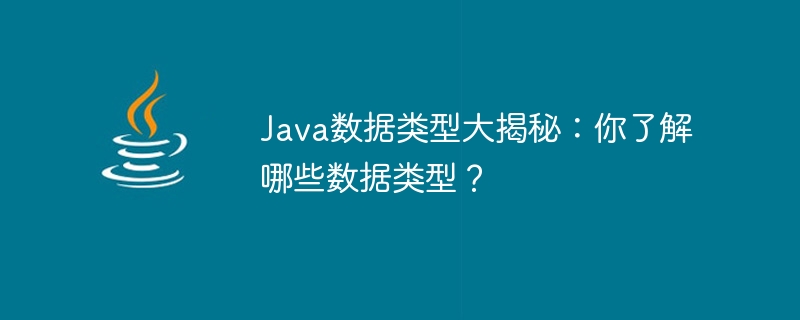Home >Java >javaTutorial >A Deep Dive into Java Data Types: What do you know about the various data types?
A Deep Dive into Java Data Types: What do you know about the various data types?
- 王林Original
- 2024-02-19 12:59:061100browse

Java data types revealed: What data types do you know?
As a Java developer, we often use various data types to store and process data. Proper use of data types is crucial to the efficiency and accuracy of your programs. In this article, we'll take a deep dive into some common data types in Java and build a deeper understanding with concrete code examples.
- Primitive data types (Primitive data types)
There are 8 basic data types in Java, they are:
- byte: Used to represent 8-bit signed integers in the range -128 to 127. Can be used to save memory, such as representing binary images.
- short: used to represent a 16-bit signed integer, ranging from -32768 to 32767. When processing large amounts of data and running out of memory, you can consider using short to reduce memory usage.
- int: Used to represent a 32-bit signed integer, ranging from -2147483648 to 2147483647. In most cases, we use int to represent integers.
- long: used to represent a 64-bit signed integer, ranging from -9223372036854775808 to 9223372036854775807. When representing particularly large integers, the long type can be used.
- float: used to represent 32-bit single-precision floating point numbers. The accuracy is about 6-7 decimal places.
- double: used to represent 64-bit double-precision floating point numbers. The precision is about 15 decimal places.
- char: used to represent 16-bit Unicode characters, ranging from 'u0000' to 'uffff'.
- boolean: used to represent Boolean values, with only two possible values: true and false.
The following is a sample code showing how to declare and initialize variables of basic data types:
byte a = 10; short b = 200; int c = 3000; long d = 1000000L; float e = 3.14f; double f = 3.14159; char g = 'A'; boolean h = true;
- Reference data types (Reference data types)
In addition to basic data types, Java also provides various reference data types. They are all defined through classes, including strings, arrays, classes, etc.
- String: used to represent a set of characters.
String str = "Hello, World!";
- Array (Array): used to store a group of elements of the same type.
int[] nums = {1, 2, 3, 4, 5};
String[] names = {"Alice", "Bob", "Charlie"};- Class (Class): used to define the structure and behavior of objects.
class Person {
String name;
int age;
public Person(String name, int age) {
this.name = name;
this.age = age;
}
public void sayHello() {
System.out.println("Hello, my name is " + name + " and I'm " + age + " years old.");
}
}
Person p = new Person("Alice", 20);
p.sayHello();- Interface: A specification used to define a set of methods that can be implemented by a class.
interface Animal {
void makeSound();
}
class Dog implements Animal {
public void makeSound() {
System.out.println("Woof woof!");
}
}
Animal d = new Dog();
d.makeSound();- Enumeration (Enum): used to define a set of constants.
enum Day {
MONDAY, TUESDAY, WEDNESDAY, THURSDAY, FRIDAY, SATURDAY, SUNDAY
}
Day today = Day.MONDAY;
System.out.println(today);The above are only part of the reference data types. There are many other types. You can learn in depth according to your actual needs.
To sum up, Java provides various data types. Reasonable selection and use of data types is crucial to the correctness and performance of the program. In this article we introduce some common data types in Java and deepen our understanding through code examples. Hope this helps you gain a deeper understanding of Java data types!
The above is the detailed content of A Deep Dive into Java Data Types: What do you know about the various data types?. For more information, please follow other related articles on the PHP Chinese website!

